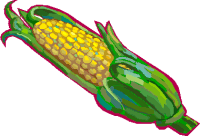

To send a message to an author, click on the author's name at the end of the article.
This Month in Ag Connection | Ag Connection - Other Issues Online
Due to the summer drought, many producers chopped drought-stressed corn for silage. Corn silage from drought-stressed corn is excellent livestock feed, although several management issues must be considered.
If the corn was too dry or not well packed as it was chopped and put in the silo, excessive spoilage could occur. Be sure to discard spoiled feed and feed only good quality material. When silage feeding begins, it isrecommended to remove 3 to 4 inches of silage from the face of the pile daily in order to prevent silage deterioration due to oxygen exposure. This should be increased to 6 inches during hot weather.

Book values for energy, represented by Total Digestible Nutrients (TDN), and crude protein (CP) indicate that drought-stressed corn silage has over 30% more energy than mature fescue hay and an estimated 10 to 20 percent more protein than normal corn silage. It is estimated that drought corn silage has 70 to 100 percent of the feeding value of normal corn silage.
Because of the variability in growing conditions, the amount of corn grain in the silage and the possibility of nitrates, it is recommended to have nutrient analysis done on the silage. Then accurate, safe feeding programs can be designed to meet the nutrient requirements of each specific group of animals a producer will be feeding.
Corn silage is an extremely versatile feed that can be used in just about any feeding program. For dry beef cows in mid-gestation, it may be best to limit the amount of silage in the rations so cows will not get excessively fat. Silage can be fed in combination with hay to stretch low hay supplies and better match the energy needs of dry beef cows. Protein and mineral supplementation may be necessary, however, so it is best to formulate diets based on the nutrient content of the silage in the pile, rather than to use book estimates of nutrient content.
If producers are feeding lactating cows or backgrounding calves, silage is also an excellent ration ingredient. There may be a need for supplemental protein, vitamins and minerals, so it is important to have feeding programs designed for the performance expectations for these animal groups as well.
Source: Gene Schmitz, MU Extension Livestock Specialist
This Month in Ag Connection | Ag Connection - Other Issues Online
When summer drought cuts the growth of forages making hay reserves for winter feeding low, it makes the need greater causing not so good management decisions.
Grass forages are not as affected by late cuttings. The growing points are found in the base or crown. The removal of summer's dormant, dry leaves actually opens the base of grasses aiding in their fall regrowth.
Well maintained grass pastures and hay fields can be productive for many years. Alfalfa fields are not so long lived even with proper care. With the trouble and expense of establishing alfalfa, proper care andmaintenance are wise management.

Poor timing of harvests during the growing season decreases stand longevity. Alfalfa roots can be weakened and damaged by repeated cuttings when root reserves are not replenished.
Most legumes like alfalfa have their growing points above ground. After harvesting, alfalfa replaces its stems and foliage from root reserves. Alfalfa stems need to be at least six to eight inches tall before some energy storage begins.
Enough energy needs to be stored to sustain the alfalfa during the winter and begin growth in the spring. In Missouri, this fall rest period is between September 15 and November 1. After the first of November, alfalfa is usually dormant and little or no growth, energy production or energy storage takes place.
After November 1 or a freeze cold enough to kill the alfalfa stems, a harvest can be relatively safe although the yield can be disappointing. A freeze of 26 to 24 degrees Fahrenheit two days in a row is usually enough. An alternative to baling is grazing.
Late fall and winter grazing of alfalfa requires fencing and compatible soils. Grazing wet, soft soils will contribute to compaction and damage to the alfalfa root and crown. Many of our central Missouri soils have high enough clay content to make fall grazing a poor choice. Late winter grazing when the soils are frozen may work better.
Another problem with alfalfa on our higher clay content soils in winter is heaving. Heaving is the pushing of alfalfa roots and crowns out of the ground from the expansion and contraction of soils from freezing and thawing. Exposed roots are often broken and damaged by direct contact to low winter temperatures. The removal of stems and foliage from fall or winter harvest allows more direct sunlight and colder air making the chance heaving conditions worse.
Any alfalfa management decision needs to be considered with the possibility of lowering next year's yields, reducing stands and shortening the life of the alfalfa field. The question is, "Do I really need that extra hay?"
Source: Jim Jarman, MU Extension Agronomy Specialist
This Month in Ag Connection | Ag Connection - Other Issues Online
The exceptionally dry fall conditions after corn and soybean physiological maturity can affect the quality of soil samples and soil-test results. The first concern is with obtaining the actual soil sample. Sampling under very dry conditions may increase soil sampling error because of the difficulty of controlling sample depth and proper soil collection. This may be a problem for phosphorus (P) and potassium (K) due to nutrient stratification which usually is more pronounced in reduced till, no-till, and pastures. Both P and K tend to concentrate at or near the soil surface and therefore, the depth control for core collection is very important. With dry soil it is often difficult to push the soil probe to a uniform depth and cracks need to be avoided. Also, when the top inch of soil is very dry and powdery it is very easy to lose this soil portion, which will affect the soil-test result significantly.
Very dry soil conditions may result in more acidic soil pH. Differences from of 0.1 to 0.3 pH units are common with very dry soils.
Short-term nutrient recycling from plant residues and the equilibrium between soil nutrient pools also may be affected by rainfall, especially for K. In moist soils, some slowly exchangeable K can become exchangeable when easily exchangeable K is depleted by plant uptake or leaching. With dry soil at the end of the growing season, this replenishment of the solution and easily exchangeable fractions, which is what soil tests measure, is limited or does not occur. These processes also occur with P, but to a much lesser extent. Preliminary research data from Iowa State suggests that with little or no rainfall from crop physiological maturity until soil sampling there is less K recycling from plant tissue and crop residue and lower soil-test K values than with normal rainfall.
With these dry conditions, taking a soil sample becomes more important. If possible, try to delay soil sampling until meaningful rainfall has occurred. This may take at least one inch or more, but this may vary by other environmental conditions and the previous crop. This will result in a better sample and more reliable soil-test results.
This time of year may not allow you to wait to soil sample. If you take soil samples under these dry conditions:
1. Be careful with sampling depth control and that you get the complete soil core in the bag.
2. Soil pH results may be a bit more acidic than it would be in normal conditions.
3. Soil K results may be lower than what they would be under normal conditions.
4. Soil P test results probably will be affected little by the recycling issue.
Source: Wayne Crook, MU Extension Agronomy Specialist
This Month in Ag Connection | Ag Connection - Other Issues Online
Two very important decisions must be made by people approaching retirement. First, when should you start receiving Social Security retirement benefits - at your full retirement age which is now 66; begin as early as age 62; or delay receiving benefits as late as age 70? The second decision pertains to farmers planning to retire prior to the full retirement age of 66. The question is - which month should you "retire" and start drawing Social Security retirement benefits?
From an individual perspective, the answer to the first question depends on an answer to another question few people know - that is how long you'll live. Given, Social Security monthly retirement benefits are permanently increased for delaying the receipt of benefits between age 62 and 70 -- the longer your life expectancy - the longer you should delay receiving Social Security retirement benefits, everything else being equal. Many people don't realize their Social Security retirement benefits could be increased 8 percent a year for each year Social Security retirement benefits are delayed between age 66 and age 70. Thus, if your monthly Social Security retirement benefit would be $2,000 per month at age 66, it would be $2,640 per month if you delayed receiving the benefit until you reached age 70 or drop to $1,500 a month if the same individual started drawing retirement benefits at age 62. It is also important to realize increased worker benefits can also translate into increased spousal benefits, thus the benefit, for a married couple, can continue to some degree for the life of the last to die.
The answer to the second question regarding month of retirement is more definitive. For grain farmers planning to start receiving Social Security retirement benefits prior to age 66, it is frequently best to begin receiving benefits in December. This is because you harvest in the fall and can plan to be retired in December. Additionally, the crops that were produced in your year of retirement can be reported as earned prior to retirement and will not count against your earned income limit for Social Security retirement benefits in the subsequent year when they are actually sold.
The Social Security Administration published final rules, effective immediately (December 8, 2010), that limit the time period for beneficiaries to withdraw an application for retirement benefits to within 12 months of the first month of entitlement and to one withdrawal per lifetime. In addition, beneficiaries entitled to retirement benefits may voluntarily suspend benefits only for the months beginning after the month in which the request is made.
In summary, there are important Social Security decisions to be made regarding your retirement. Too many people believe there is little they can do to control the amount of Social Security retirement benefits they'll receive. However, in the example cited above, the monthly retirement benefit varied from $1,500 to $2,640 a month, simply dependent on when they started drawing the benefit.
Source: Parman Green, MU Extension Ag Business Specialist
This Month in Ag Connection | Ag Connection - Other Issues Online

We would like to introduce Brent Carpenter, our new Agricultural Business Specialist in the Central Missouri region. Brent holds degrees from Texas Tech University and Abilene Christian University; M.S., Agricultural Economics, 1989 and B.S., Animal Science, 1983, respectively. Brent served for ten years as Extension Farm Management Specialist in south-central Missouri and was also a Research Associate with the Food and Agricultural Policy Research Institute (FAPRI) at the University of Missouri. He discovered honest work through experiences ranging from livestock production to swinging a railroad spike maul.
Brent will be based in Pettis County Extension Center,but will also serve Benton, Cooper, Morgan, and Moniteau Counties.
This Month in Ag Connection | Ag Connection - Other Issues Online
Publishing Information
Ag Connection is published monthly for Northeast and Central areas of Missouri producers and is supported by the University of Missouri Extension, the Missouri Agricultural Experiment Station, and the MU College of Agriculture, Food and Natural Resources. Managing Editor: Mary Sobba.